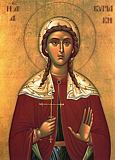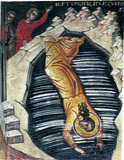

| Previous day | Next day |
| Old Style
March 20
|
Tuesday |
New Style
April 2
|
|
4th Week of Great Lent.
Tone 3.
Great Lent. |
Monastic rule: xerophagy (bread, uncooked fruits and vegetables).
|
![]() The Holy Fathers who were slain at the Monastery of St. Sabbas: Sts. John, Sergius, Patrick, and others (796).
The Holy Fathers who were slain at the Monastery of St. Sabbas: Sts. John, Sergius, Patrick, and others (796).
Martyrs Photina (Svetlana), the Samaritan woman; her sisters Phota, Photis, Parasceva, and Cyriaca; her sons Victor (or Photinus) and Joses; and Sebastian the Duke, the officer Anatolius, and Theoclitus, the former sorcerer—all martyred under Nero (ca. 66). Seven Virginmartyrs of Amisus (Samsun): Alexandra, Claudia, Euphrasia, Matrona, Juliana, Euphemia, and Theodosia (310). St. Nicetas the Confessor, bishop of Apollonias in Bithynia (9th c.). Suffering of St. Euphrosynus of Blue-Jay Lake (Novgorod) (1612).
Righteous Abel, first martyr in the history of mankind. St. Martin of Braga in Iberia (580). St. Cuthbert of Lindisfarne, bishop (687). St. Herbert of Derwentwater, priest and hermit (687). Hieromartyr Tadros, bishop of Edessa, at Jerusalem (691). Martyr Michael the Sabbaite, at Jerusalem (691). St. Wulfram, missionary (Neth.) (703). Martyr Archil II, king of Georgia (744). New Martyr Myron of Mega Castro on Crete (1793). New Hieromartyr Nicholas Holz, priest, of Novosiolki (Chelm and Podlasie, Poland) (1944).
Thoughts for Each Day of the Year
According to the Daily Church Readings from the Word of God
By St. Theophan the Recluse

Tuesday.
Baptism according to Apostle Peter is the answer of a good conscience toward God (I Pet. 3:21).[1] He who has been baptized gives a vow to live the rest of his time according to a pure conscience, according to the whole breadth of the Lord’s commandments, accepted in his conscience. Moral purity is a characteristic of one who is baptized. The Apostle Paul compares the brightness of this life with the brightness of the resurrected Lord. That like as Christ was raised up from the dead by the glory of the Father, even so we also should walk in newness of life (Rom. 6:4). In baptism, the old sin-loving man dies and a new man arises, zealous to do good works. Likewise reckon ye also yourselves, ye who are baptized, to be dead indeed unto sin but alive unto God through Jesus Christ our Lord. Let not sin therefore reign in your mortal body, that ye should obey it in the lusts thereof. Neither yield ye your members as instruments of unrighteousness unto sin: but yield yourselves unto God, as those that are alive from the dead, and your members as instruments of righteousness unto God. For sin shall not have dominion over you (Rom. 6:11–14).
[1]The Slavonic for I Pet. 3:21 reads: the promise of a good conscience toward God
Articles
 Martyred Holy Fathers who were slain at the Monastery of St SabbasSaints John, Sergius, Patrick and others were slain in the Monastery of Saint Sabbas. |
 Martyr Kyriake of RomeSaint Kyriake was the sister of the Holy Martyr Photina (Svetlana) the Samaritan Woman, with whom the Savior conversed at Jacob’s Well (John. 4:5-42). |
 Martyr Archil II the King of GeorgiaThe Holy Martyr Archil II, King of Georgia belonged to the dynasty of the Chosroidoi, and he was a direct descendant of the holy emperor St Mirian (+ 342). |









